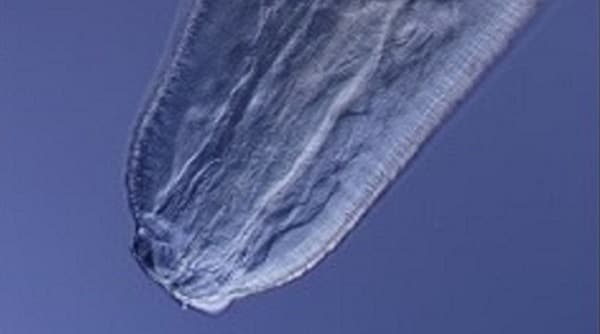Key points
- Anisakiasis is a disease caused by a parasite.
- A parasite is an organism (a living thing) that lives on or inside another organism.
- Anyone who eats undercooked or raw fish or squid is at risk.
- You can prevent getting anisakiasis by not eating raw or undercooked fish or squid.

Overview
Anisakiasis (also known as herring worm disease) is a parasitic disease caused by nematodes (worms) that attach to the walls of the esophagus, stomach, or intestine.
Anisakiasis is most commonly found in areas where eating raw fish is popular, such as Japan. Because eating undercooked fish is becoming more common, there have been cases in the US, Europe, South America, and other areas of the world.
Signs and symptoms
People with anisakiasis can experience signs and symptoms such as
- Abdominal pain
- Nausea
- Vomiting
- Abdominal distention (abnormal abdominal expansion)
- Diarrhea
- Blood and mucus in stool
- Mild fever
People can also experience allergic reactions such as
- Rashes
- Itching
- Infrequently anaphylaxis (a severe, life-threatening allergic reaction)
Some people experience a tingling sensation during or after eating raw or undercooked fish or squid. This sensation is actually the worm moving in the mouth or throat. People can often take the worm out of their mouth themselves or cough it up to prevent infection. Some people experience vomiting, which can often expel the worm from the body.
How it spreads
When certain infected marine mammals (e.g., whales or sea lions) defecate (poop) in the sea, they release eggs. These eggs become infective larvae while in the water. Crustaceans (e.g., crabs, lobsters, shrimps) consume the infective larvae, and then fish or squid consume the crustaceans.
When humans eat raw or undercooked infected fish or squid, they consume the nematode larvae, which can invade the gastrointestinal tract. Eventually, the parasite dies and produces an inflamed mass in the esophagus, stomach, or intestine.
People cannot spread anisakiasis to one another.
Prevention
To prevent anisakiasis, do not eat raw or undercooked fish or squid.
Food precautions
The FDA recommends the following for seafood preparation or storage to kill parasites:
Cooking (Seafood in General)
- Cook seafood adequately (to an internal temperature of at least 145° F [~63° C]).
Freezing (Fish)
- At -4°F (-20°C) or below for 7 days (total time), or
- At -31°F (-35°C) or below until solid, and storing at -31°F (-35°C) or below for 15 hours, or
- At -31°F (-35°C) or below until solid and storing at -4°F (-20°C) or below for 24 hours.
Learn more about safe food handling practices: The Core Four Practices of Food Safety | FightBAC.
Diagnosis
Your healthcare provider can diagnose anisakiasis by endoscopy, radiography, or surgery if the worm is embedded. It is helpful for your healthcare provider to know if you ate undercooked fish or squid.
Treatment and recovery
Your healthcare provider may remove the worm from your body through endoscopy or surgery.
This information is not meant to be used for self-diagnosis or as a substitute for consultation with a health care provider. If you have any questions about the parasites described above or think that you may have a parasitic infection, consult a health care provider.
